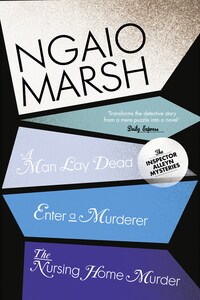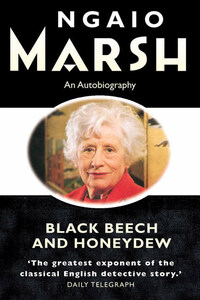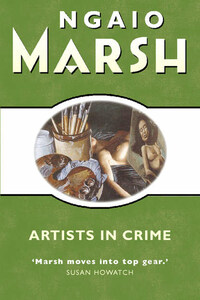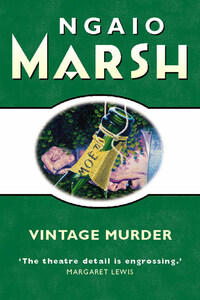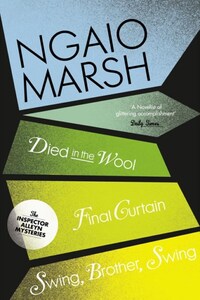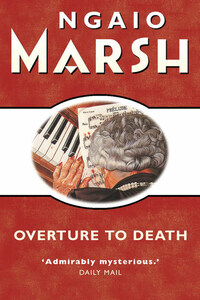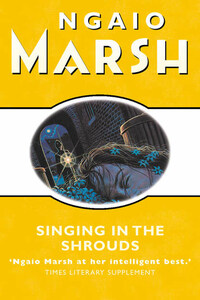HarperCollinsPublishers Ltd.
1 London Bridge Street
London SE1 9GF
www.harpercollins.co.uk
A Man Lay Dead first published in Great Britain by Geoffrey Bles 1934
Enter a Murderer first published in Great Britain by Geoffrey Bles 1935
The Nursing Home Murder first published in Great Britain by Geoffrey Bles 1935
Roderick Alleyn and Moonshine first published in Great Britain in Death on the Air and Other Stories by HarperCollinsPublishers 1995
Ngaio Marsh asserts the moral right to be identified as the author of these works.
Copyright © Ngaio Marsh Ltd 1934, 1935
Roderick Alleyn and Moonshine copyright © Ngaio Marsh (Jersey) Ltd 1989
A catalogue copy of this book is available from the British Library.
This novel is entirely a work of fiction. The names, characters and incidents portrayed in it are the work of the author’s imagination. Any resemblance to actual persons, living or dead, events or localities is entirely coincidental.
All rights reserved under International and Pan-American Copyright Conventions. By payment of the required fees, you have been granted the non-exclusive, non-transferable right to access and read the text of this ebook on screen. No part of this text may be reproduced, transmitted, down-loaded, decompiled, reverse engineered, or stored in or introduced into any information storage and retrieval system, in any form or by any means, whether electronic or mechanical, now known or hereinafter invented, without the express written permission of HarperCollins ebooks
HarperCollinsPublishers has made every reasonable effort to ensure that any picture content or written content in this ebook has been included or removed in accordance with the contractual and technological constraints in operation at the time of publication
Source ISBN: 9780007328697
Ebook Edition © June 2013 ISBN: 9780007531462
Version: 2018-09-04
He was born with the rank of Detective-Inspector, CID, on a very wet Saturday afternoon in a basement flat off Sloane Square, in London. The year was 1931.
All day, rain splashed up from the feet of passers-by going to and fro, at eye level, outside my water-streaked windows. It fanned out from under the tyres of cars, cascaded down the steps to my door and flooded the area. ‘Remorseless’ was the word for it and its sound was, beyond all expression, dreary. In view of what was about to take place, the setting was, in fact, almost too good to be true.
I read a detective story borrowed from a dim little lending library in a stationer’s shop across the way. Either a Christie or a Sayers, I think it was. By four o’clock, when the afternoon was already darkening, I had finished it, and still the rain came down. I remember that I made up the London coal fire of those days and looked down at it, idly wondering if I had it in me to write something in the genre. That was the season, in England, when the Murder Game was popular at weekend parties. Someone was slipped a card saying he or she was the ‘murderer’. He or she then chose a moment to select a ‘victim’, and there was a subsequent ‘trial’. I thought it might be an idea for a whodunit – they were already called that – if a real corpse was found instead of a phony one. Luckily for me, as it turned out, I wasn’t aware until much later that a French practitioner had been struck with the same notion.
I played about with this idea. I tinkered with the fire and with an emergent character who might have been engendered in its sulky entrails: a solver of crimes.
The room had grown quite dark when I pulled on a mackintosh, took an umbrella, plunged up the basement steps and beat my way through rain-fractured lamplight to the stationer’s shop. It smelt of damp news-print, cheap magazines, and wet people. I bought six exercise books, a pencil and pencil sharpener and splashed back to the flat.
Then with an odd sensation of giving myself some sort of treat, I thought more specifically about the character who already had begun to take shape.
In the crime fiction of that time, the solver was often a person of more or less eccentric habit with a collection of easily identifiable mannerisms. This, of course, was in the tradition of Sherlock Holmes. Agatha Christie’s splendid M Poirot had his moustaches, his passion for orderly arrangements, his frequent references to ‘grey cells’. Dorothy L Sayers’s Lord Peter Wimsey could be, as I now am inclined to think, excruciatingly facetious. Nice Reggie Fortune said – and author H C Bailey had him say it very often – ‘My dear chap! Oh, my dear chap!’ and across the Atlantic there was Philo Vance, who spoke a strange language that his author, S S Van Dine, had the nerve to attribute, in part, to Balliol College, Oxford.
Faced with this assembly of celebrated eccentrics, I decided, on that long-distant wet afternoon, that my best chance lay in comparative normality: in the invention of a man with a background resembling that of the friends I had made in England, and that I had better not tie mannerisms, like labels, round his neck. (I can see now that with my earlier books I did not altogether succeed in this respect.)
